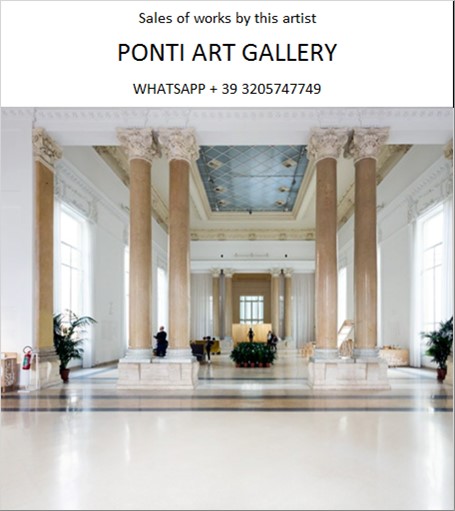Ponti Art Gallery is interested in buying and selling works
of art by this artist.

Robert Rauschenberg Biography
Robert Rauschenberg, born Milton Ernest Rauschenberg on October 22, 1925, in Port Arthur, Texas, was a pivotal figure in the transition from Abstract Expressionism to the more object-oriented approaches of Pop Art and Neo-Dada. His innovative works, which incorporated materials from everyday life, anticipated and influenced the Pop art movement, making him one of the most significant American artists of the 20th century. Rauschenberg's career, spanning over six decades, was marked by his experimentation across a wide range of mediums including painting, sculpture, prints, photography, and performance.
Rauschenberg's early life in Texas did not immediately point him towards a career in art. He knew little about the subject until a visit to an art museum during his service in the U.S. Navy in World War II sparked his interest. After the war, he pursued art education at the Kansas City Art Institute from 1946 to 1947 and briefly studied in Europe at the Académie Julian in Paris. However, it was his return to the United States and subsequent enrollment at Black Mountain College in North Carolina under the Bauhaus master Josef Albers, and later at the Art Students League in New York City, that truly shaped his artistic direction.
At Black Mountain College, Rauschenberg was introduced to a community of artists and thinkers who played a crucial role in his development. It was here that he met composer John Cage and dancer Merce Cunningham, with whom he would later collaborate extensively. These collaborations were foundational in Rauschenberg's approach to art, emphasizing the integration of various disciplines and the breaking down of boundaries between mediums.
Rauschenberg's early works in the 1950s, including his all-white and all-black paintings, began to challenge the prevailing abstract expressionist aesthetic with their incorporation of non-traditional materials and objects. His "Combine" paintings, which he began creating in the mid-1950s, further blurred the lines between painting and sculpture by integrating found objects such as stuffed animals, newspapers, and pieces of furniture into the canvas. These works not only questioned the nature of art but also reflected Rauschenberg's belief in the interconnection between art and life.
One of Rauschenberg's most controversial and celebrated works from this period is "Erased de Kooning Drawing" (1953), for which he asked the established abstract expressionist Willem de Kooning for a drawing that he could erase as an artistic statement. This act of erasure was a bold challenge to traditional notions of authorship and creativity and remains a landmark in the history of modern art.
In the 1960s, Rauschenberg continued to innovate with his "Silkscreen Paintings," which incorporated transferred images from newspapers and magazines, reflecting the bombardment of media and commercial imagery in American culture. This technique prefigured and paralleled developments in Pop Art, particularly the work of Andy Warhol.
Beyond his visual art, Rauschenberg was deeply involved in performance, working with the Merce Cunningham Dance Company and co-founding the interdisciplinary organization Experiments in Art and Technology (E.A.T.) in 1967. E.A.T. sought to foster collaborations between artists and engineers, leading to groundbreaking works that incorporated emerging technologies.
Rauschenberg's later years were marked by continued experimentation and a global perspective, influenced by his travels through the Rauschenberg Overseas Culture Interchange (ROCI) project, which aimed to promote world peace and mutual understanding through art. Throughout his career, Rauschenberg received numerous awards, including the Praemium Imperiale for painting in 1998, acknowledging his profound impact on the art world.
Robert Rauschenberg passed away on May 12, 2008, in Captiva Island, Florida, leaving behind a legacy that continues to inspire and challenge artists today. His work, characterized by its openness to materials and its challenge to traditional boundaries, remains a testament to his belief in the potential of art to transform and enrich human experience.
Robert Rauschenberg Quotes and
Sales of Works
Ponti Art Gallery selects and deals with paintings by the
artist. Upon request, we provide free estimates and
evaluations, communicate prices, quotations, and current
market values.
If you are interested in BUYING or SELLING works by the
artist, contact us immediately.
If you wish to sell or receive an evaluation of the
works:
Send us a frontal photo of the painting, one of the back,
and one of the signature. Also, indicate the dimensions of
the work. Inform us about the purchase origin of the work
and any kind of available documentation (purchase
receipts, certificates of authenticity, publications). One
of our operators will respond to you on the same day. We
guarantee maximum confidentiality and extreme
professionalism.
If you wish to purchase works by the painter: Contact us
and let us know your request. We will inform you about the
available works. We also offer the possibility to
subscribe to our NEWSLETTER, through which you will be
informed at the beginning of each month about the latest
acquisitions of the art gallery.
You can send us pictures of the work:
